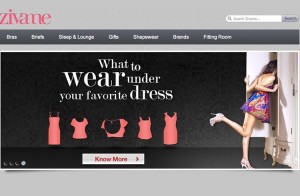In the early 1990s, there was mostly one multi-retail outlet selling everything together, from cosmetics to lingerie to baby products, all under one roof. This categorisation of lingerie with baby food and cosmetics has prevailed for a very long time. But over the last few decades, India saw a massive change with the entry of players like Marks and Spencer, La Senza, and very recently, the virtual space has exploded with lingerie portals and nearly all e-commerce players today have a separate lingerie/innerwear segment specifically targeting the niche audience with Elitify selling brands like BCB Generation, Calvin Klein, Agent Provocateur (Penelope Cruz’s Brand), the well-known US acclaimed brand, Hanky Panky and Straps & Strings selling Oscar de la Renta, Cosabella and Canadian brand Blush.

A recent study undertaken jointly by Yahoo and Mindshare has thoroughly analysed the shopping behaviour of customers to reveal that 31 per cent shoppers opt for online shopping in order to save the time and effort that might be spent on physically going to stores to buy the same products.
About 28 per cent customers are driven to buy online due to the availability of discounts and promotions while the convenience to shop anywhere, anytime attracts the remaining 21 per cent.
The ecommerce landscape with its dynamic outlook is large and is rapidly evolving too and the study also attaches figures to talk about the trend of buying through mobile devices, like the phone and the tab. The research highlights the role of mobile from the top of funnel to the bottom and how it varies across product categories. According to the survey, majority of consumers use only mobile devices while making purchases related to apparels, electronic devices, baby and pet care products.
Most purchases made online over mobile phones tend to be regular or impulsive buys rather than expensive ones, the study claims.
Over 90 per cent of the consumers use mobile devices for quick and frequent purchases, contrary to 36 per cent who purchase high consideration products. And about 30 per cent people prefer buying products of personal hygiene from the store itself.The study earmarks and predicts that the consumer path-to-purchase is turning more complex and nonlinear, with mobile at the centre of this evolution.
In order to answer to the needs of the tech savvy consumers and fulfill the e cart wishes of the generation who prefer shopping with their fingers, more and more lingerie brands are adapting the e-commerce model. The normal shopping portals are gearing up to accommodate better and bigger lingerie names in their shopping portfolio. And all this is made possible through seamless shopping experience that they are able to provide by offering a variety in their collection and a decent pricing clubbed with exciting offers and promotions.
A report compiled by marketing research firm eMarketer pronounces that the ecommerce sales in India are expected to grow from US$14 billion in 2015 to US$55 billion in 2018.
Pure-play e-commerce companies such as Flipkart Ltd, Snapdeal (Jasper InfotechPvt. Ltd) and Amazon Seller Services Pvt. Ltd will see more competition, with brick-and-mortar entities such as the Tata group and the Aditya Birla Group announcing plans to enter India’s growing e-commerce market. Omni channel is also becoming a significant threat model for the brands who only exist through their ecommerce entities.
However, online retail during mid-2015 accounted for 0.8% of all retail sales in India, compared with a global average of 6.3%, and e-Marketer forecasted this would grow to 4.8% by 2019, when it is projected to be 12.8% globally.
With a compound annual growth rate of 30% the e-commerce market that was valued at Rs.1.2 trillion at the end of December 2015 will touch Rs.2.1 trillion by December 2016, according to the Digital Commerce Report 2015, by the Internet and Mobile Association of India (IAMAI) and IMRB International.
While in May last year, the e-commerce biggies clocked a gross merchandise value, or GMV, run rate of US$9 billion, that number has only inched up to about $10 billion at the end of May this year, translating into an 11% annual growth. And most of this stagnancy and stiffness can be attributed to the reshuffling and finally coming into being of the fresh guidelines for foreign domestic investments (FDI) in e-commerce.
The Centre has finally allowed, 100 per cent FDI in the marketplace-based model — an arrangement where e-commerce companies provide an online platform to other vendors to sell their products. However, in the marketplace model, despite the lack of clarity, it was assumed that FDI was allowed; foreign companies used this route to set up e-shops. Domestic companies, such as Flipkart, which accepted foreign investments too switched to the marketplace model.
Post March this year, most e-tailers have reduced promotional campaigns after the centre introduced new policy guidelines for online marketplaces. The fresh rules prohibit online retailers from offering discounts directly. Cash burn for Amazon, for instance, had risen up to almost US$80-90 million per month in the early part of the year.
While most of the lingerie industry ecommerce portals operate through an inventory model, they were able to snatch in some FDI in the past and were enjoying their fair share in the ecommerce industry. However owing to the reshuffling of the FDI policies, they had to undergo and are still processing a lot of policy changes to suit themselves well amidst the changing times.
Far from the maddening crowd
This High Street women online fashion store is a self-funded company with no external funding from neither Domestic nor International investor. So revisions in FDI policies have not really affected N-Gal Fashion.
“E-Commerce is a big space with huge scope for both marketplaces and brand’s online shopping websites. Marketplaces have evolved much faster than later in terms of soaring sales figures but that may just not stand true when we measure the profit making capability.
The India’s story of e-commerce is actually clouded with humongous discounts offering spree from major marketplaces, wherein a brand’s online shop can take leverage in controlling discounts as brands are more personalised in reaching out to customers.
So profitability with brand’s websites are better than marketplaces even though the sales figures may not reflect the actual picture. Moreover, the competition is fierce among the all marketplaces where same products are available on almost all the major marketplaces and there is limited scope for new player in marketplace domain,” explains Manu Pathania, Founder, N-Gal  while elaborating on the concept of online marketplace. N-Gal maintains a physical stock that is supplied to their offline retails partners, online channel partners and n-gal.com. This accounts for a reasonable cumulative online sales of upto 60% of their total sales, rest of the 40% is coming from offline retails. N-Gal is concentrating on scaling up their offline retails sales for better brand awareness.
while elaborating on the concept of online marketplace. N-Gal maintains a physical stock that is supplied to their offline retails partners, online channel partners and n-gal.com. This accounts for a reasonable cumulative online sales of upto 60% of their total sales, rest of the 40% is coming from offline retails. N-Gal is concentrating on scaling up their offline retails sales for better brand awareness.  There has been a major change/growth from inception. The brand has seen a growth of almost 500% from inception. But for the last year the sales have not been as per expectation. So plans are underway to invest more in customer acquisition and retention through investment in technology. “As a part of this investment plan, we are going to launch N-Gal mobile app in a short span,” adds Manu Pathania.
There has been a major change/growth from inception. The brand has seen a growth of almost 500% from inception. But for the last year the sales have not been as per expectation. So plans are underway to invest more in customer acquisition and retention through investment in technology. “As a part of this investment plan, we are going to launch N-Gal mobile app in a short span,” adds Manu Pathania.
Even though the founder feels that offers do initiate good sales, but he is sure that what is on offering on the portal defines the long term customer building and retention. Owing to this, he feels COD as a choice to the customer, at least for a first time buyer is a must on a portal. That makes them feel more confident and secure.
Ratio for N-Gal is about 60/40 (Prepaid/COD). Maintaining good quality through a competitive price margin and great customer services, N-Gal overall faces about 4%-7% returns / exchange rate as compared to the ceiling high sales figure.
Enamor however believes that lingerie is a woman’s most intimate expression of herself and that the right one can make every woman feel fabulous every day. Ever since the brand was launched in 2003 in collaboration with Barbara of Paris, Enamor has built a strong bond with the consumer to ensure that every style meets Indian body requirements, by being the only brand to offer wearer trials and multi-size fits. Enamor has also won hearts since inception and grown to be the most trusted brand amongst urban Indian ladies – recently recognized as Superbrand 2014-15!
The goal of each offering at Enamor has always been to provide international trends that meet global quality standards to the consumers. With this in mind, Enamor endeavours to create lingerie that enables the experience of feeling fabulous every day! A survey conducted by CashKaro.com India’s largest Cashback & Coupons site shows that 90% of women feel it’s worth investing n sexy lingerie as it makes them feel & look confident.
 In this survey among many relevant figures what has also surfaced is that the most preferred lingerie website stores for women are Zivame, Clovia, Jabong and Pretty Secrets whereas the top rated brands include Jockey, Lovable and Enamor.
In this survey among many relevant figures what has also surfaced is that the most preferred lingerie website stores for women are Zivame, Clovia, Jabong and Pretty Secrets whereas the top rated brands include Jockey, Lovable and Enamor.
Enamor has indeed surfaced as a brand closer to the women, owing to their offerings and their presence both online and offline. “Both the stores & online portal has its own share of customers. With the global change and e-sector booming, website has seen a sea change in the response but stores still has its own charm to allure its customers. Also we have had an impressive sales figure achievement over the last five years,” commented the spokesperson for Enamor.
They indeed have a clean online inventory model and are quite blissfully enjoying their own niche space and has nothing much to bother about owing to the policy changes or the ecommerce regulations altering every next day. But Enamor still has a friendly online offering and allows the customers 5 day return benefits on every purchase.
Sticking to online goals
One of the fastest growing intimate apparel online portal, Private Lives has not had any effect on their sales, owing to the reshuffling of the FDI policies and rules that came along with these changes. They are determined towards giving a great product to our customers at a reasonable price and we are satisfied as far as that goal is being met.
www.privatelives.in is a website for our online and offline customers. The major chunk of our sales comes from our stores and so many times customers come back online to check out the brand. Our website is also designed to give them the correct positioning. We have a pretty decent catalogue and are satisfied with our offering. We sell about 500 garments a month at www.privatelives.in,” cited Ankit Kapoor, Founder, Private Lives. He has no intentions open the portal to other brands and just want to stick to their exclusive consumer e portal model even in future. The sales for the brand have grown at an average rate of 50% per annum accounting to a 20% Annual growth.
 Clovia a full-fledged manufacturer which designs in house, procures raw material and just outsources manufacturing to 3rd party job workers under strict observations from their quality teams. The company tightly controls the full development cycle for its products sold under the Clovia Brand. Since Clovia does not have a marketplace format so the revision in FDI policies does not have an effect on Clovia. “To clarify, we are not an online marketplace. Clovia.com is an online branded store for Clovia lingerie. The brand has been growing at 100% QoQ since inception. There are over 1.5 Mn visitors to clovia.com monthly. Over 70% sale now is through Mobile Web and App. The clovia products, styles and the value proposition are strong enough to be currently delivering some of the best conversion rates industry wide!” mentioned Pankai Vermani, CEO, Clovia. A brand that lives and breathes its product line. Clovia creates small quantities and replenished based on consumer feedback. Hence most of their range is literally decided by the customer themselves. Also the strong production process can deliver more than 250 new
Clovia a full-fledged manufacturer which designs in house, procures raw material and just outsources manufacturing to 3rd party job workers under strict observations from their quality teams. The company tightly controls the full development cycle for its products sold under the Clovia Brand. Since Clovia does not have a marketplace format so the revision in FDI policies does not have an effect on Clovia. “To clarify, we are not an online marketplace. Clovia.com is an online branded store for Clovia lingerie. The brand has been growing at 100% QoQ since inception. There are over 1.5 Mn visitors to clovia.com monthly. Over 70% sale now is through Mobile Web and App. The clovia products, styles and the value proposition are strong enough to be currently delivering some of the best conversion rates industry wide!” mentioned Pankai Vermani, CEO, Clovia. A brand that lives and breathes its product line. Clovia creates small quantities and replenished based on consumer feedback. Hence most of their range is literally decided by the customer themselves. Also the strong production process can deliver more than 250 new  designs every month with some of the industry’s best turn-around-times and with minimal exposure to inventory. As a result they’ve never felt the need for introducing more brands to grow their basket. With Total 250,000Units shipped monthly, Clovia humbly mentions that they’re still just scratching the surface of the innerwear category. Their range launch plan is covered for the next 2 years!
designs every month with some of the industry’s best turn-around-times and with minimal exposure to inventory. As a result they’ve never felt the need for introducing more brands to grow their basket. With Total 250,000Units shipped monthly, Clovia humbly mentions that they’re still just scratching the surface of the innerwear category. Their range launch plan is covered for the next 2 years!
“We’ve grown 100% QoQ form the beginning. The business has been a very strong unit economic wise and has operated with exceptional business fundamentals even at a time when other companies using the ecommerce channels were bleeding money. We continue to follow the same philosophy. In last one year, Clovia.com has seen 4 times growth in terms of dispatch. The eStore now contributes to 60% of overall sales,” responds Pankai Vermani.
Strictly opposing the discounting model, Clovia nurtures the idea of promoting the value packs. Their strategy is ‘buy more to save more’. Over the past few years, discounting has proven to be a major enabler for people to buy online. But for a huge percentage of people, reach, discovery of good products and privacy (as in our category) have also been serious drivers of this channel.

Clovia now sells through their owned eStore clovia.com, almost all the major e-commerce portals, where they have leadership position and the just launched clovia shop-in-shops in 9 major airports in India. The lack of knowledge about various sizes and fits makes it difficult for client to choose perfect size and design. Clovia has come up with a breakthrough technology to create a tool called the “Fit Test” to solve this fundamental problem. By just entering age and body shapes (which are pictorially represented), it suggests the right size and fit. We offer an easy exchange policy of 30 day return and have a low return rate of 3-4%. Almost 65%+ pay via cash-on-delivery. We think this number will grow as more tier 2 tier 3 towns start to transact online.
While many of these online lingerie portals either exclusively follow the ‘my product-my consumer’ format or they are solely a self-funded company, with no hassle to raise funds. But then there are some who have from the beginning maintained a very different portfolio and have cleverly utilised the online platform in such a way that they could quite comfortably enjoy the benefits from every quarter. While Clovia chalking out the future roadmap confirmed to a more concretely different model a few years back, by changing from ‘Moods of Cloe’ to Clovia.
On the other hand Pretty Secrets has always taken a smart move and have stayed ahead of the other lingerie etailers in terms of their ecoomerce moves. This Mumbai based online lingerie company Pretty Secrets began distributing their products in bulk to retailers’ pan-India through their online B2B online e-commerce platform psretailer.com a year back. And their online portal is solely an inventory based model, who reaches out to their consumers through a third party network and is a segment leader on most online marketplaces like Myntra, Jabong, Flipkart, etc.
“This model makes us a solely B2B inventory online lingerie brand, and thus we are not harmed owing to the FDI policy changes,” responds Karan Behal, founder & CEO, Pretty Secrets. Only recently they have closed a series B round of funding led by Singapore fund RB Investments with participation by existing investors Orios VP and HNI Harish Shah.
A brand that sells almost one lingerie a minute Zivame is counted among the leaders in the online lingerie marketplace arena. Showing a 300% YoY growth rate Today, Zivame claims to draw 70 per cent revenue from its in-house brands. And close to 30 per cent of the revenue comes from Tier II and III cities. Category shapewear has seen a 336 per cent increase in one year. Today, more than 60 per cent of Zivame’s traffic comes from mobile and the company is confident that this will grow, as told to us by a source close to the company.
The source also revealed that the recent turn of events and the declaration of FDI policies have altered the dynamics of the brand to a great extent and the brand who called themselves ‘India’s Biggest Online undergarment store’ is indeed busy accommodating the changes so that they can well suit themselves within the changing norms and are not too ready to embark upon the idea of being an online lingerie marketplace.
The brand, probably the first in its category has last been in the news, after they raised a Series C round of Rs 250 crore investments from Zodius Technology Fund and Khazanah Nasional Berhad, the strategic investment fund of the Government of Malaysia. Zivame also has a tie up with e wallet FreeCharge and customers can easily pay using this wallet on the Zivame website. Also much recently Online lingerie retailer Zivame has announced their intentions of opening experience stores in three cities by this month.
The new stores will come up in Pune, Delhi and Gurugram by July, and in Chandigarh and Cochin by the end of August.
These stores will only be customer touch points and will not store inventory. Zivame already has opened its first such store in Bengaluru’s Indiranagar area in December last year. The company is also aiming to open stores in Sri Lanka and Nepal in almost a year’s time. While on the one hand they call themselves the leaders in online lingerie marketing, on the other their intention to reach out through offline stores gives rise to a deluge of questions which of course the sources deny to answer by repeatedly saying that a lot is underway.
With many unclear questions looming around the hedge, the biggies of etail are certainly facing their own share of twists and turns. While Myntra made their way back to the espace with their website and now proudly owns Jabong who in FY15 had net revenue of US$122.3 mn, as was brought out in public earlier this month. Gross Merchandise Value in the current quarter saw an 8.4 per cent increase, with the company doing business worth US$61.1 mn. It had 2.6 mn successful orders on the portal, up from 2.1 mn in the corresponding quarter last year.
Sources close to the company had mentioned that the brand is switching gears to bring more focus on premium brands and shed low-margin products. To suit the policy changes, they have also begun phasing out discounts. This is a pattern its biggest competitors, Flipkart-owned Myntra and Voonik, also seem to be following at the moment. Jabong had been merged with four international fashion portals, valued collectively at US$2.7 billion.
Even though we were unable to retrieve direct lingerie related figures from these key e shopping portals, but we are surely waiting to see how these online reputed stores adjust to the policy changes and disclose the exact model they swallow to embrace the policy changes to the best of their benefits.















Great thinikng! That really breaks the mold!